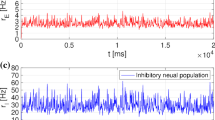Abstract
Biological neural networks are high dimensional nonlinear systems, which presents complex dynamical phenomena, such as chaos. Thus, the study of coupled dynamical systems is important for understanding functional mechanism of real neural networks and it is also important for modeling more realistic artificial neural networks. In this direction, the study of a ring of phase oscillators has been proved to be useful for pattern recognition. Such an approach has at least three nontrivial advantages over the traditional dynamical neural networks: first, each input pattern can be encoded in a vector instead of a matrix; second, the connection weights can be determined analytically; third, due to its dynamical nature, it has the ability to capture temporal patterns. In the previous studies of this topic, all patterns were encoded as stable periodic solutions of the oscillator network. In this paper, we continue to explore the oscillator ring for pattern recognition. Specifically, we propose algorithms, which use the chaotic dynamics of the closed loops of Stuart–Landau oscillators as artificial neurons, to recognize randomly generated fractal patterns. We manipulate the number of neurons and initial conditions of the oscillator ring to encode fractal patterns. It is worth noting that fractal pattern recognition is a challenging problem due to their discontinuity nature and their complex forms. Computer simulations confirm good performance of the proposed algorithms.












Similar content being viewed by others
References
Babloyantz A, Salazar JM, Nicolis C (1985) Evidence of chaotic dynamics of brain activity during the sleep cycle. Phys Lett A 111(3):152–155
Skarda CA, Freeman WJ (1987) How brain make chaos in order to make sense of the world. Behav Brain Sci 10:161–195
Adachi M, Aihara K (1997) Associative dynamics in a chaotic neural network. Neural Netw 10:83–98
Breve FA, Zhao L, Quiles MG, Macau EN (2009) Chaotic phase synchronization and desynchronization in an oscillator network for object selection. Neural Netw 22:728–737
Ishii S, Sato M (1998) Associative memory based on parametrically coupled chaotic elements. Phys D 121:344–366
Zhao L, Caceres JCG, Damiance APG Jr, Szu H (2006) Chaotic dynamics for multi-value content adressable memory. Neurocomputing 69:1628–1636
Zhao L, Cupertino TH, Bertini JR Jr (2008) Chaotic synchronization in general network topology for scene segmentation. Neurocomputing 71:3360–3366
Zhao L, Breve FA (2008) Chaotic synchronization in 2D lattice for scene segmentation. Neurocomputing 71:2761–2771
Grossberg S (1987) Competitive learning: from interactive activation to adaptive resonance. Cogn Sci 11:23–63
Kohonen T (2001) Self-organizing maps, 3rd edn. Springer, Berlin
Silva T, Zhao L (2012) Network-based high level data classication. IEEE Trans Neural Netw Learn Syst 23:954–970
von der Malsburg C (1981) The correlation theory of brain function. Technical report, Max-Planck-Institute for Biophysical Chemistry
Wang D (2005) Time dimension for scene analysis. IEEE Trans Neural Netw Learn Syst 16:1401–1426
Hopfield JJ (1982) Neural networks and physical systems with emergent collective computational abilities. Proc Natl Acad Sci USA 79:1554–1558
Borisyuk RM (2013) Spiking neural network mode for memorizing sequences with forward and backward recall. BioSystems 112:214–223
Yamaguchi Y (2003) A theory of hippocampal memory based on theta phase precession. Biol Cybern 89:1–9
Popovych OV, Yanchuk S, Tass PA (2011) Delay and coupling-induced firing patterns in oscillatory neural loops. Phys Rev Lett 107:228102
Yanchuk S, Worfrum M (2008) Desestabilization patterns in chains of coupled oscillators. Phys Rev E 77:026212
D’Huys JDO, Vicente R, Fischer I (2010) Amplitude and phase effects on the synchronization of delay-coupled oscillators. Chaos 20:043127
Perlikowski P, Yanchuk S, Popovych OV, Tass PA (2010) Periodic patterns in a ring of delay-coupled oscillations. Phys Rev E 82:036208
Jurgens H, Peitgen HO, Saupe D (1992) Chaos and fractals: new frontiers of science. Springer, New York
Acknowledgments
The authors would like to thank CNPq of Brazil under grant number 306227/2011-8 and FAPESP of Brazil under grant numbers 2011/50151-0 and 2013/07375-0 for financial support.
Author information
Authors and Affiliations
Corresponding author
Rights and permissions
About this article
Cite this article
da Silva, F.A.O., Zhao, L. A Network of Neural Oscillators for Fractal Pattern Recognition. Neural Process Lett 44, 149–159 (2016). https://doi.org/10.1007/s11063-015-9473-y
Published:
Issue Date:
DOI: https://doi.org/10.1007/s11063-015-9473-y




